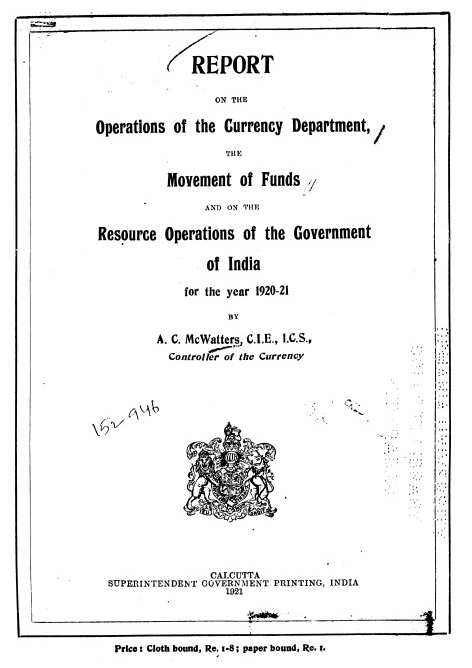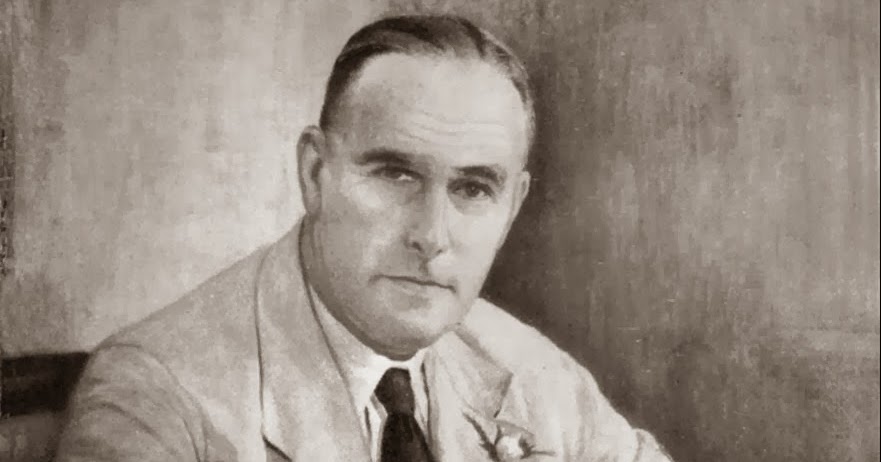The New Report on Currency and Finance

The Reserve Bank of India released its new Report on Currency and Finance (RCF) in February this year. This comes nearly a decade after the previous issue. The RCF is a non-statutory report, unlike the Annual Report and Report on Trend and Progress of Banking in India (RTP). The former is published under the Reserve Bank of India Act, 1934. The RTP is published under the Banking Regulation Act, 1949. The 2021 RCF is significant in three ways. It is the centenary of the first consolidated report of the Controller of the Currency, which became the RCF. For the first time, it is a discussion paper on a specific issue. It is also the first issue of RCF with a foreword signed by the Governor, Reserve Bank of India. The RCF has had a chequered history, which is worth recounting.
The Beginnings: 1861 – 1935
The new British Raj, which replaced the East India Company in India, introduced paper currency in 1861. It was part of reforms to set right government finances which were in disarray following the “Sepoy Mutiny” of 1857.
Paper Currency Department
To implement the new Act, the government established a Paper Currency Department (PCD). This department initially worked through the Presidency Banks, which were issuing their currencies prior to 1861. These banks had to be compensated for its perceived loss of prestige, and the privilege and profit from issuing paper currency. The paper currency management later worked through the mints. Thereafter, the PCD became part of the Office of the Comptroller and Auditor General (C&AG). In 1913, the government hived off the function as the Office of Controller of the Currency.
Not trusting the Presidency Banks to remain prudent in times of stress, the government mandated periodical statements from the PCD. This was to ensure that the note issue remained within limits determined by the value of underlying reserves. These reports became the “Annual Reports of the Head Commissioner of Paper Currency on Operations of the Paper Currency Department”. It later became part of the C&AG’s annual reports.
Controller of Currency
From 1913, when the government established an Office of Controller of Currency, it started submitting separate provincial reports. From 1921, these merged into a “Report on the Operations of the Currency Department, the Movement of Funds and on the Resource Operations of the Government of India.” The Controller of the Currency addressed these reports to the Finance Secretary.

Apart from managing currency and ensuring adequate reserves, the Controller also oversaw the internal and external value of the currency. For this, his Office gathered information ranging from bullion prices to industrial activities and international trade. It shared its data and analyses with the government and the public, by extending the scope of the report beyond mundane currency-related matters. It typically covered exchange and trade including bullion movement, commodity prices, implementation of the recommendations of the currency committee/commission reports, government transactions, money and securities markets, government relations with the Presidency Banks/Imperial Bank of India, demand for different types of currency, notes in circulation, and the functioning of scheduled banks. The comprehensive nature of the Report was perhaps responsible for shorterning its former grandiose title to a mere “Annual Report of Controller of Currency.”
After 1935
After the Reserve Bank of India was established in April 1935, the Controller’s functions were gradually transferred to the Bank before abolishing the Office in September 1937. The Controller’s report, discontinued in 1935, was reborn as the RCF in 1937. The first issue covered the Bank’s first two years, and was similar to the Controller’s Report. It is intriguing why the Controller’s Report was revived when the Bank, after taking over the Controller’s functions, could have covered them in its annual reports. The Bank’s official history does not throw light on this, but informed conjectures and reasonable conclusions are possible.
Why RCF introduced
First, researchers and policy makers requested continuance of the Controller’s report, for “statistical continuity.” Second, the Bank’s Annual Report of 20-odd pages was limited to management, organization, activities, and accounts. Incorporating a nearly 100-pages long Controller’s Report was neither envisaged nor practical. Thirdly, consistency and comparability required that the data relate to the government’s financial year (April to March). Incorporating the financial year data would have been too late for the Bank’s annual report which had to be released soon after its financial year. In those early years, this was from January to December.
Fourth, the Bank presented its data in a form vastly different from that of the Controller. Therefore, if the demand for comparability were to be conceded to, it required that the original format be retained. Fifth, the abolition of the Controller’s Office, establishment of the Bank’s Statistical and Research Section, and publication of the RCF, all happened in 1937. This was not mere coincidence. The staff of the Controller’s Office was absorbed by the Bank. Those working on physical currency moved to the Bank’s Issue Departments. At the same time, those working in research and publication sections had to be suitably employed.

Lastly, Sir James Taylor, the second Governor, was the one who apparently steered the exercise. He was with the Office of Controller of Currency for over a decade as Deputy Controller, Officiating Controller, and Controller, also signing a few series of notes. As the Controller, he had also forwarded the Annual Report to the Finance Secretary. He would have had no qualms in reversing the decision of his predecessor, Sir Osborne Smith, with whom he had several long-drawn battles, big and small, as Deputy Governor. This is a story for another day.
Coverage of RCF
After the initial period when the Report on Currency and Finance mimicked the annual reports of the erstwhile Controller of Currency, it came into its own in the 1940s. CD Deshmukh, the third Governor of the Bank, gave “a new format, content and authority” to the RCF. This was also when Deshmukh converted the Statistical and Research Section into a full-fledged Department under J.V. Joshi, one of Keynes’s ‘star pupils’ at King’s College, Cambridge, recruited from the government to become the Bank’s first Economic Adviser.
Changes since the 1960s
The RCF coverage changed over the years. Till 1963, it covered everything from the German invasion of Poland to the Korean War. That year, it dropped covering international economic developments. In 1977, it added a separate section on Review and Outlook. A new addition was a large section on banking, encroaching into RTP territory. This coverage later extended to include ECGC, DICGC, and NABARD. This gives rise to speculation whether the different divisions in charge of the three main publications were competing with each other. At the same time, bullion continued to be under Currency and Coinage, even though currency had snapped its connection with metals decades earlier.
As we have seen, the RCF had its origins in the introduction of paper currency by the government. But, over the years, the coverage of currency became restricted to two to four pages. This continued to be the case even after the RCF became a nearly 800 page document, and by 1975 went into two volumes. “Currency and Coinage” went out of the list of contents in 1997. The following year, it also lost its sub-heading status . This became “the most unkindest cut of all.”
Concerns about continuance
In course of time, the government’s Economic Survey, and the Bank’s Annual Report and RTP, improved their coverage and quality. New institutions such as the Central Statistical Organization started publishing their data. In this scenario, the continuation of RCF became increasingly untenable. The Bank sought its readers’ views in the 1960s as regards continuing RCF. Surprisingly, most respondents, including well-known scholars, pleaded for continuance. The Bank complied. But, it added a caveat that the RCF was a staff report, unlike the other two, issued under Central Board authority. Undue delays, indicating low priority, further diminished the status of the RCF. In some issues, the Director of Publications apologised for the “palpable delay,” a euphemism for being a few years beyond schedule.
The RCF in new format
The year 1999 was a watershed. In what was a bold initiative, the Report on Currency and Finance became theme-based. The first such issue covered the structural transformation of the Indian economy. Subsequent issues of the RCF covered a broad range of themes such as Monetary Policy, Central Banking, and the Global Financial Crisis. Each issue was quite comprehensive and self-contained with a wealth of detail and reference. Each one is a collector’s item, the best in the literature. No wonder then that the Bank chose to reissue these in several volumes.
It is debatable whether continuing the legacy of the RCF was necessary even in a different format. The ability to sustain annual themes of such a high order required an imagination and calibre of a high order. Thus, three years’ RCF merged into one in 2012. This was perhaps due more to lack of ownership than any other reason. Thereafter, there was a long lull. Everyone seemed to believe that the Bank had quietly buried the RCF.
Revival and Rationale
But, things changed this year. A new issue came out in February 2021. This issue reviewed the monetary policy framework, due five years after the new framework came in 2016. Thus, from the status of a theme-based comprehensive study, the RCF is now in effect a discussion paper.
One of the reasons given for reviving the RCF is the alleged link of its title with Keynes’s first book, Indian Currency and Finance, published in 1913. This connection is at best tenuous. Neither the official histories nor C.D. Deshmukh, the sole memoirist Governor of the period, suggest it. Nor is J.V. Joshi, the Bank’s first Economic Adviser, one of Keynes’s “most brilliant students” quoted as saying so. Nor does Anand Chandavarkar, the ardent Keynes-admirer who had worked under Joshi, suggest it in his scholarly Keynes and India.
A historical link, if at all, is with the only two commissions on Indian currency, Chamberlain (1914) and Hilton Young (1926). These were “Royal Commissions on Indian Currency and Finance.” In its final report, Chamberlain reversed the order to “Indian Finance and Currency.” This was perhaps not to confuse with Keynes’s book. In view of the Commission covering the same terrain, Keynes hurriedly completed and published the book. I will cover the full story of how Keynes became the youngest Commissioner of the Chamberlain Commission in another post due soon.
Conclusion
The Report on Currency and Finance had its origins in a period when central banking functions were with different organizations. From its exalted status as the first defining official central banking publication, it initially became one among many. Then it became a theme-based report, and finally a discussion paper. In this chequered journey, it resembled a poor and uninvited distant relative, neither welcome nor to be ignored or discarded. A quiet and dignified burial was an honourable option. Now that the Bank has revived the RCF, it will be difficult to put the proverbial genie back in the bottle. Keen observers of central banking will fondly hope that the new RCF will stay relevant and influential in the coming years.
© G. Sreekumar 2021.
For periodical updates on all my blog posts, subscribe for free at the link below:
https://gsreekumar.substack.com/
![]()